Shasta Daisies (Leucanthemum x superbum)
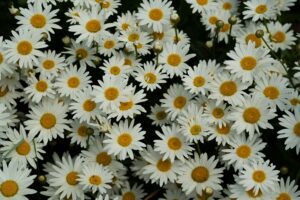
Light: Full to part sun. Mine are in part sun – probably about 6 hours of sun on summer mornings. Filtered sun the rest of the day as they are shaded by a big hickory tree. They bloom beautifully so in my experience, part sun does not lessen the amount of blooms as happens in some plants.
Soil and water: Average garden soil. Moist, but well drained – and well-drained is important. This plant does not like soggy soil.
Hardiness Zones: Zones 5-9. IMPORTANT!!! If you live west of the Mississippi River, and most especially in the southwest, Montana, anywhere in what is considered to be cattle country, or any place where there are pastures for grazing animals, please check with your state or county offices and find out if Oxeye Daisy is a problem in your area – invasive. This is a prolific plant from Europe that can take over sizeable portions of grasslands. It is a lovely plant, but livestock will not eat it. And Oxeye Daisy will choke out plants livestock will eat. One of the parent plants of Shasta Daisies is Oxeye Daisy. If you do choose to grow Shastas, deadhead them as soon as the flowers start to fade – do not allow them to form seedheads. They will spread by underground runners, but only in a small area which you can easily control. It is the seeds that cause them to be invasive.
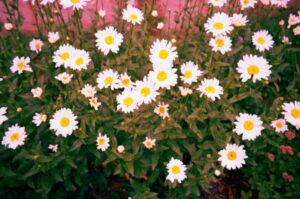
Size: This depends on the variety or cultivar. It is important to read the plant tags of whichever Shasta Daisy you choose. Their range of height is from about 8 inches to 3 feet tall. Width will also vary. If you allow them, and there is room, the taller Shastas will spread out to form a mat and will bloom profusely. This is what I allow mine to do and in my experience, one plant will form a mat that is about 18-20 inches by 18-20 inches, and it will take about 3 years for this size mat to form. If 3 or more Shastas are planted about 24-28 inches apart from each other, a larger mat will form and so Shastas can be used as a ground cover. Once the flowers are finished and deadheaded so only the green mat of leaves remains, although Shastas will not tolerate a lot of foot traffic, they will tolerate a once a month weeding where you are walking and kneeling on them. Just tread lightly and sparingly. However, I have found that their mats do a good job of suppressing weeds and so there is never much weeding to be done. And when weeding within the mat, I often kneel at the periphery of the mat, lean in, and just cut the weeds off at ground level. The Shastas will do a good job choking out the roots of the weed so actually digging down within the mat to get the weed’s roots is not always necessary. The weed will sometimes regrow, but will be less and less vigorous until it disappears.
Bloom period and color. Deadheading: Traditionally, all Shasta flowers were white daisies with bright yellow centers. There are now yellow varieties and recently, a pink variety has been developed. And notice in the photos below, besides the color change, there is also a change in shape of the flowers. I have no experience with any of these newer varieties. Keep in mind that often when a plant is hybridized or manipulated, it becomes less hardy and is, overall, a bit weaker. All Shasta Daisies have been developed by botanists and hybridizers. There is no native Shasta Daisy. Because of this, Shasta Daisies are already considered to be a more short-lived perennial. My guess is the yellow and pink varieties – or the white ones with the manipulated flower shapes – could be even shorter-lived. Just keep that in mind before you purchase. More colors could be developed in the future as botanists and plant hybridizers work with this plant. All Shasta Daisies are generally in full bloom in June and into July – about 6-7 weeks. Regardless of color or shape of flower, all Shasta Daisies are treated and grown in the same manner.
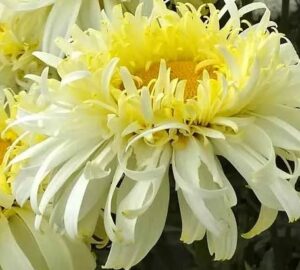
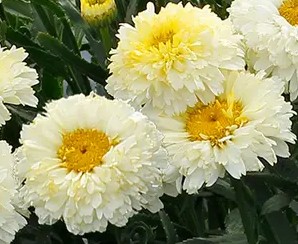
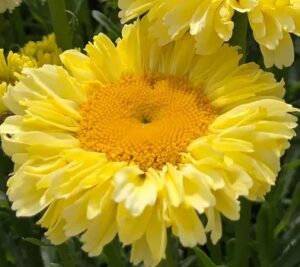
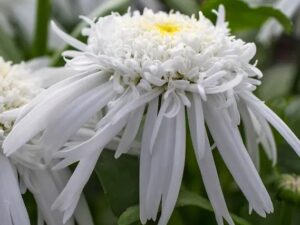
Deadhead these plants in the same way as you would deadhead Purple Coneflowers. Here is a link: Purple Coneflower (Echinacea purpurea) . Once there, scroll down to Bloom period and color. Deadheading. Instructions begin with the second paragraph.
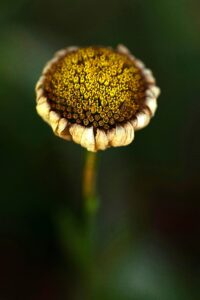
I strongly recommend that all Shasta Daisies be deadheaded as the flowers fade – do not allow them to set seed. (Note: If you choose not to deadhead, the seedheads do add a certain texture to your garden, but keep in mind, many of these seeds will not produce this exact plant, but will often revert to the parent plants – one of which is Oxeye Daisy. Oxeye Daisy is often considered invasive in any area where there are grasslands, meadows, and pastures.) Once Shasta Daisies are completely finished blooming – which is generally by early August – cut the flower stems off at ground level. What will be left for the rest of the summer and fall is the green mat of leaves which is attractive.
Because the mats are slow to form and grow, it is easy to keep Shasta Daisies to a smaller width. Just use an edger or spade to cut back any part of the plant you do not want – you will need to do this about once a year – spring, fall, or after the plant has finished blooming are the best times. Often these cuttings with their roots make good starter plants for elsewhere in your garden or to give to friends. In my experience, it is only the taller Shastas that widen out. I have grown the 8-inch-tall varieties and I have never had to cut or edge them back. They are short and less wide.
I have tried the short varieties and they generally work as annuals for me – I have trouble wintering them over regardless of when I deadhead, where I place them, or how I treat them. Gardening is endlessly interesting! If you chose to try them, I hope your luck is better than mine!
Insects, Butterflies and Birds: I have always had Shasta Daisies in all my gardens. When I lived in southeastern Pennsylvania and most especially in the mountains of southeastern West Virginia, butterflies and moths regularly came to these flowers. Here in Illinois, we do not get many – or any – butterflies and moths until late August into October and Shasta Daisies are finished blooming generally in late in July, so the timing is off. If you have butterflies and moths from late spring on, then they will come to these daisies.
I always deadhead my Shastas as the flowers fade to prolong the bloom, and so I do not allow seed heads to form. I have never seen goldfinches on the seedheads in other gardens, but it is my guess that sparrows and juncos eat the seeds that have fallen to the ground. Those birds clean up a lot of fallen seed!
Deer, rabbits, and other pests: I have had Shastas in all my gardens and never had anything bother them – even when a mother rabbit had her successful nest at the base of a daylily planted right next to them. They have also not been bothered by deer, aphids, or any plant disease. However, your experience could be different. If you have a lot of trouble with rabbits and deer, I suggest spraying the newly emerged plants in spring with a repellent and follow the directions as to how often to spray. There are plant diseases that will occasionally affect Shasta Daisies, but the best prevention is to plant them in well-drained soil. It is wet soil that allows these diseases to attack Shastas.
Propagating and transplanting: I have had good luck transplanting Shasta Daisies. It is recommended that you divide Shasta Daisies every other year. I try to do it every three years. This is a plant that seems to get refreshed with dividing and transplanting and that does seem to prolong its life. Also, the new transplants should have at least a five-year lifespan so by dividing every three years, you will always have Shasta Daisies somewhere in your garden.
I wait until my plants are at least three years old, then I use an edging blade or spade to cut through the mat of the plant. I most often cut the mat in half but if your mat is larger, you could get three to four nice pieces. I then carefully dig around the pieces and under the roots to lift them gently out. Make sure each piece has a nice clump of roots. They should be transplanted in a hole of the same depth, but a bit wider. This is a good time to add fresh soil or compost around the roots. Firm the soil around the roots, then water each piece well. Check the soil around the plants before watering again. If you have had rain, you may not need to water. To check if you need to water, scrape the mulch away from the base of the plant, place some soil in your hand, and squeeze gently. If it holds together as it would if you were squeezing a piece of cake, then the soil is moist and you do not need to water. If the soil feels dry and it does not hold together, the plant needs watered. If the soil forms a muddy mess in your hand, there is too much water so do not water for at least a week and then test again. When you do water, water with about half a 2-gallon watering can about twice a week for the first month, then once a week for the next month.
What to plant with Shasta Daisies: I think just about everything goes well with Shasta Daisies. It is a wonderful, fairly long-blooming, white-flowered plant in June and most of July – one of the best times in your summer flower garden. It just seems to go with everything. If you are using a lot of native plants, regardless of where you live, the major colors are orange and yellow. There are not a lot of white native plants that are easy to obtain, so these white daisies with their bright yellow centers provide a wonderful contrast to all the yellow and orange. I have mine planted in groups of 3 or 6-7 and have allowed them to grow together and form mats. And when they bloom, they are a solid mass of white. I have them planted next to Asiatic lilies that bloom gold and bronze, orangish pink daylilies, orange Butterfly Weed, and purple Betony. All of these bloom in June and July and provide a mass of gorgeous color and texture.
How to use this plant: If you are using the shorter varieties or cultivars, they can be massed as a border along a sidewalk, a mulched path, or at the edge of your flower bed. If you want continuous bloom, I would advise planting annuals with them, as the Shastas will only bloom in June and July leaving you without blooms in the other months. However, if continuous bloom is not necessary, then as the last flowers fade, deadhead the flower stems at ground level and the plants will form small green mats with attractive, small darker green leaves. If you are using the taller varieties or cultivars, you can plant them in groups of 3 and allow them to form mats. They are slow to spread, but the mass of white daisies they produce in June and July is just spectacular. They can also be planted singly all around your garden – the white is such a good accent color. And they will draw butterflies and moths wherever you plant them.
One thing I want to add – and this is solely a personal preference. I have tried a lot of the varieties and cultivars – and remember it is true that plants grow differently in different gardens – but my favorite Shasta Daisy is Becky. This is an older variety and it grows like a champ. I think it is longer lived and it is tough as nails. If you have never tried Shasta Daisies, and you have room for one of the taller varieties, I would recommend Becky.

